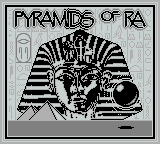Retro Replay Review
Gameplay
Pyramids of Ra centers on a deceptively simple but deeply engaging puzzle-platform formula. You step into the boots of an intrepid archaeologist navigating a series of tile-laden tombs, each level a self-contained maze that demands both precision and planning. Your objective is clear: stand on every tile to weaken it, then leap off to shatter it, clearing your path toward the exit. Yet the true challenge emerges once you realize you must fracture all tiles before returning to the very first square to trigger the next stage.
(HEY YOU!! We hope you enjoy! We try not to run ads. So basically, this is a very expensive hobby running this site. Please consider joining us for updates, forums, and more. Network w/ us to make some cash or friends while retro gaming, and you can win some free retro games for posting. Okay, carry on 👍)
The level design in Pyramids of Ra is where the gameplay truly shines. Initial stages introduce you to modest grids and predictable tile patterns, but as you progress the layouts become labyrinthine, with dead ends, chokepoints, and strategic tile placements that force you to think two or three moves ahead. Jumping mechanics feel tight and responsive, ensuring that precision leaps—especially those that span gaps or dodge spikes—are entirely within your control.
Beyond the vanilla break-and-return core, the game spices things up with environmental hazards and subtle power-ups. Pressure plates may lock portions of the floor, and crumbling ledges can wedge you into precarious spots if you’re not careful. Conversely, golden scarabs grant temporary immunity to collapsing tiles or allow a double-leap to reach otherwise inaccessible spots. These elements inject fresh variety, preventing the core loop from feeling repetitive even after dozens of levels.
Graphics
Visually, Pyramids of Ra pays homage to classic 8-bit and 16-bit aesthetics while incorporating modern polish. The hand-drawn tile textures evoke the worn sandstone of ancient Egyptian tombs, and subtle color gradients give each room a sense of depth and atmosphere. Flickering torchlight animations cast dancing shadows along crumbling walls, enhancing the feeling of isolation and danger.
Character sprites are charmingly detailed, with your archaeologist sporting a wide-brimmed hat, dusty boots, and a trusty whip at his side. Animation frames for running, jumping, and vaulting feel snappy, lending the platforming segments a weighty feel. Enemies—scarabs, mummies, and spectral guardians—move in predictable yet menacing patterns, their pixel-perfect walk cycles and haunting idle poses reinforcing the game’s thematic cohesion.
Each tomb boasts a distinctive palette, from the sepia-toned entry halls to the deep teal monolith chambers and blood-red ceremonial rooms. The UI is minimal but informative, displaying a small map, remaining tiles count, and an optional timer. During your playthrough, the score and timer remain discreet, ensuring the focus stays on solving puzzles rather than obsessing over metrics.
Story
While Pyramids of Ra prioritizes puzzles and platforming, it weaves a light narrative thread that propels you forward. You play as Dr. Eleanor Briggs, a daring archaeologist on the cusp of uncovering a Pharaoh’s lost treasure. Brief cutscenes between worlds reveal journal entries and hieroglyphic sketches, hinting at curses, rival tomb raiders, and hidden chambers beyond the main maze.
The storytelling is minimalist but effective, relying on environmental clues and scattered scrolls to flesh out the world’s lore. Unlocked murals depict the rise and fall of the Sun God Ra, while crumbling statues and sealed sarcophagi give context to the traps you’ll encounter. This approach allows players to absorb backstory at their own pace without interrupting the puzzle flow.
Midway through the campaign, a surprise twist elevates the stakes: a familiar rival archeologist appears, racing you through mirrored tombs and triggering tile-collapse traps of their own design. The friendly rivalry not only adds freshness to level objectives but also deepens your connection to Dr. Briggs’s motivations. By the time you face the final tomb, you’re invested in both the puzzle mastery and the fate of Egypt’s greatest treasure.
Overall Experience
Pyramids of Ra strikes a satisfying balance between accessible mechanics and escalating challenge. Early levels serve as a gentle tutorial, while later stages demand meticulous planning, quick reflexes, and an intimate understanding of tile patterns. It’s the kind of game that rewards repeated attempts, as each failure teaches you a little more about optimal routes and timing.
The game’s pacing is well judged: intermittent boss-style puzzle rooms break up the standard levels, offering extended sequences where you must clear multiple floors under a time constraint or dodge dynamic hazards. Checkpoints are generous, so grinding through difficult sections feels fair rather than punishing. A built-in level editor and online sharing further extend replayability, inviting players to craft their own tombs and compete with friends.
For potential buyers, Pyramids of Ra represents an excellent blend of nostalgia and innovation. Its core tile-breaking mechanic is deceptively simple but blossoms into a deep puzzle experience. Coupled with evocative graphics, a light yet engaging narrative, and robust level design, this title is a strong recommendation for fans of retro-inspired platformers and cerebral puzzle games alike. Dust off your pickaxe and dive into the tombs—you may find more than just treasure waiting in the shadows.
 Retro Replay Retro Replay gaming reviews, news, emulation, geek stuff and more!
Retro Replay Retro Replay gaming reviews, news, emulation, geek stuff and more!








Reviews
There are no reviews yet.